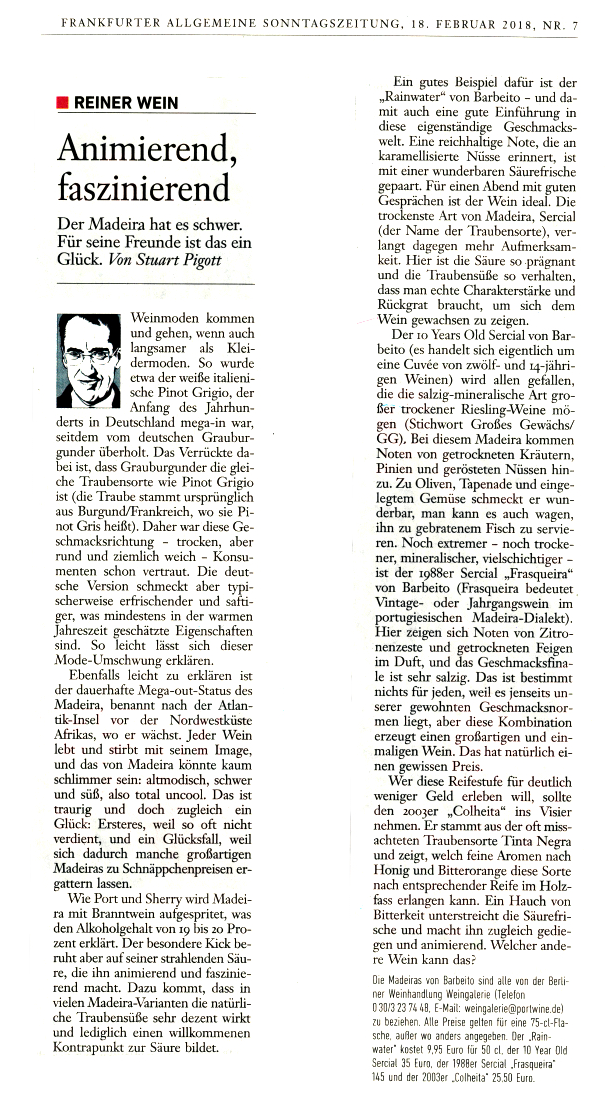PURE WINE
Animating, fascinating
Madeira has a hard time. For his friends this is lucky. By Stuart Pigott
Wine fashions come and go, albeit more slowly than clothing fashions. For example, the white Italian Pinot Grigio, which was mega-in in Germany at the beginning of the century, has since been overtaken by the German Pinot Gris. The crazy thing is that Pinot Gris is the same grape variety as Pinot Grigio (the grape originally comes from Burgundy/France, where it is called Pinot Gris). Therefore this taste - dry, but round and rather soft - was already familiar to consumers. The German version, however, typically tastes fresher and juicier, which are appreciated characteristics at least in the warm season. That's how easy it is to explain this change in fashion.
Also easy to explain is the permanent mega-out status of Madeira, named after the Atlantic island off the north-west coast of Africa, where it grows. Every wine lives and dies with its image, and Madeira's image couldn't be worse: old-fashioned, heavy and sweet, totally uncool. This is sad and yet at the same time a stroke of luck: the former because it often doesn't deserve it, and the latter a stroke of luck because it allows some of Madeira's greats to be bought at bargain prices.
Like port and sherry, Madeira is sprinkled with brandy, which explains the alcohol content of 19 to 20 percent. The special kick, however, is based on its radiant acidity, which makes it animating and fascinating. In addition, in many Madeira varieties the natural grape sweetness is very discreet and only forms a welcome counterpoint to the acidity.
A good example of this is Barbeito's "Rainwater" - and thus also a good introduction to this independent world of taste. A rich note, reminiscent of caramelised nuts, is paired with a wonderful acidity freshness. For an evening with good
The wine is ideal for conversations. The driest type of Madeira, Sercial (the name of the grape variety), on the other hand, requires more attention. Here the acidity is so concise and the grape sweetness so restrained that one needs real strength of character and backbone to show oneself to the wine.
The 10 Years Old Sercial from Barbeito (actually a cuvée of twelve- and 14-year-old wines) will please everyone who likes the salty-mineral nature of great dry Riesling wines (keyword Großes Gewächs/GG). With this Madeira come Add notes of dried herbs, pine and roasted nuts. It goes well with olives, tapenade and pickled vegetables, or you can dare to serve it with fried fish. Even more extreme - even drier, more mineral, more complex - is the 1988 Sercal "Frasqueira" from Barbeito (Frasqueira means vintage wine in Portuguese Madeira dialect). Here, notes of lemon zest and dried figs appear in the fragrance, and the Geschmacksfinale is very salty. This is certainly not for everyone, because it is beyond our usual taste norms, but this combination produces a great and unique wine. This, of course, has a certain price.
Who wants to experience this maturity level for considerably less money should take the 2003 "Colheita" in his sights. It comes from the often disregarded grape variety Tinta Negra and shows what fine aromas of honey and bitter orange this variety can achieve after appropriate ripening in wooden barrels. A hint of bitterness underlines the acidity and makes it at the same time dignified and animating. What other wine can do this?
The Madeiras from Barbeiıo are all available from an an Berliner Weinhandlung Weingalerie (phone 030/3237448, e-mail: weingalerie@portwine.de). All prices are valid for a 75 cl bottle, unless otherwise stated. The Rainwater costs 9,95 Euro for 50 cl, the 10 Year Old Sercial 35 Euro, the 1988 Sercial "Frasqueira" 145 and the 2003 "Colheita" 25,50 Euro (50 cl).
Translated with www.DeepL.com/Translator




